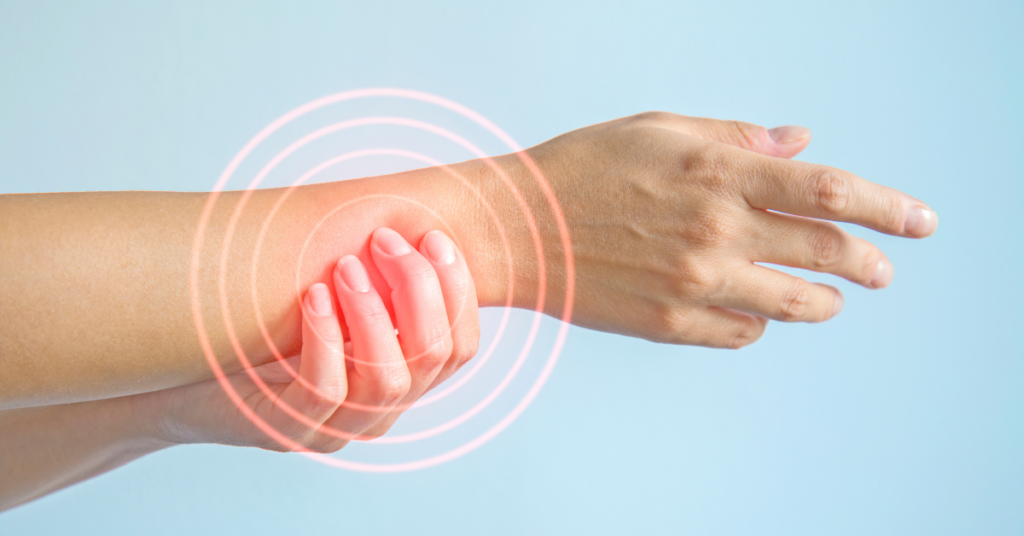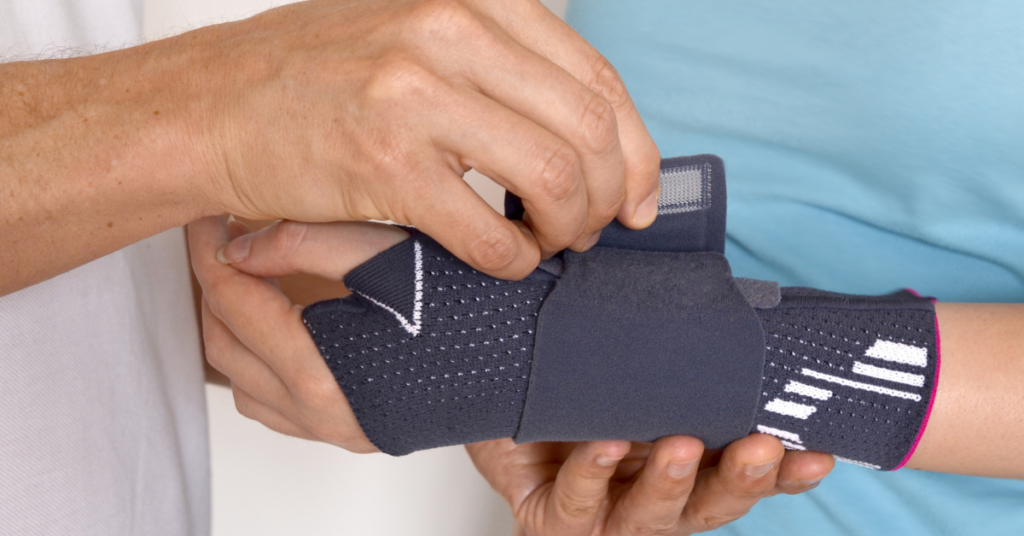Exercise Daily – having issues dealing with wrist cracking as an athlete or fitness enthusiast is pretty annoying and painful. Not only in the gym, but it can occur while doing many other sports from golf to racketball, to weightlifting activities, or even at work!
In this guide, we will discuss the causes of wrist popping or cracking and how to prevent it from happening. Moreover, in the end, we will also look at how you can crack your wrist without hurting yourself.
Let’s start with the basics and understand its causes, treatments, and preventions.
What is Wrist Cracking?
Crepitus, often known as popping and cracking in the wrist, is an unpleasant sensation that can occur during a variety of daily tasks, including typing, weightlifting at the gym, and gardening.
Unfortunately, it is not always possible to determine where the joint noise is coming from. Paying attention to your symptoms might help you discover the probable reason, though.
The information below outlines the most prevalent reasons why your wrist is producing noise.
Common Causes of Wrist Cracking or Popping

Instability of the Joints
When the bones of the wrist move excessively or abnormally, it can cause the joints to become unstable, which can result in popping or cracking noises. There are a lot of reasons why this sort of instability might arise.
Accidents involving vehicles or falls onto outstretched hands, for example, can result in a subluxation (partial separation of a joint) or a dislocation of a joint, depending on the severity of the injury (a complete joint separation).
This might happen at any one of your wrist joints or at a number of them. In some cases, this sort of damage may also be followed by one or more of the following:
- Disruption of a ligament
- Fracture
- Cartilage damage
All of these factors might lead to the development of wrist instability.
The triangular fibrocartilage complex is one of the most commonly damaged areas of the wrist that can lead to wrist instability (TFCC).
On the ulnar, or fifth-finger, side of the wrist, a collection of ligaments and cartilage work together to provide stability.
Following a traumatic injury to this area, the natural mobility of your joints is disrupted, and crepitus might develop when you move your hand in a certain way.
As a result of chronic disease, further instances of joint instability might arise. The body’s ligaments and connective tissue become slack or loose in certain persons with hypermobility diseases, including Marfan syndrome and Ehlers-Danlos syndrome.
This results in excessive movement of the joints in these individuals (also known as being double-jointed).
As a result of this hypermobility, joints are frequently subluxated or dislocated, even during relatively harmless movements or activities, resulting in wrist cracking.
This joint disturbance can also result in crepitus, which can progress to early-onset osteoarthritis in the long run.
Other Signs and Symptoms
Following a severe injury, you may experience these symptoms:
- A significant amount of pain and inflammation in the region of impact
- Bruising on the palm of the hand, the wrist, or the upper arm
- Symptoms of inflammation include redness, swelling, and warmth to the touch in the same regions
Damage to your bones, cartilages, or ligaments that make it difficult or impossible to execute basic hand and wrist movements.
Chronic (long-term) causes of wrist instability can produce a range of additional symptoms, depending on the illness. These symptoms include:
- Changes in the degree of flexibility
- Pain that is widespread
- Extreme tiredness (despite having gotten a full night’s sleep)
- You’re having issues with your bladder or bowel movements.
Treatment
Following a fall or other form of trauma, imaging is frequently required in order to determine the extent of the damage.
Radiology studies are generally performed to rule out a broken bone, and MRI studies may be required to evaluate additional tissues such as ligaments and cartilage.
Depending on the extent of the injury, therapy may include the following steps:
- Anti-inflammatory medications
- Splints that limit your range of motion
- Cortisone injections
- Healing the bones or soft tissue via surgery
In order to effectively treat wrist hypermobility associated with chronic diseases such as Marfan or Ehlers-Danlos syndromes, it is necessary to improve joint stability in your joints. This can involve the following:
- Exercises for gentle muscle strengthening
- Physical therapy
Additional drugs such as pain relievers and anti-inflammatory medications can be used to treat wrist cracking.
A splint can also be used to temporarily restrict wrist mobility, as well as the discomfort and cracking that comes with it.
When Should You Visit a Doctor?
When a high-velocity collision or fall happens, it is critical to have the injury evaluated by a physician as soon as possible. Failure to do so may raise the risk of more damage occurring, which will extend the length of time it takes to heal.
Additionally, if your wrist crepitus is accompanied by any of the additional symptoms listed below, it is recommended that you consult with a doctor:
- Widespread pain
- Hypermobility in a number of other joints as well
- Dysfunction of the bowels or bladder
- Excessive tiredness on a daily basis
If you have hypermobility disorder, a complete assessment will help you receive an accurate diagnosis and establish whether or not you have the condition.
De Quervain’s Tenosynovitis

In addition to de Quervain’s tenosynovitis, there are additional tendon-related issues that can produce cracking noise around the wrist.
Muscle tendons pass through a sheath, which is a tunnel-like structure that allows them to glide smoothly when the muscles relax and contracts.
De Quervain’s disease is characterized by inflammation of the tendon sheath at the base of the thumb, which results in increased friction in the affected region.
As a result, when the thumb is moved, a wrist cracking feeling is felt on the inside of the wrist.
Other Signs and Symptoms
The following are some of the symptoms of de Quervain’s tenosynovitis:
- Hand motions such as grasping or twisting can cause pain on the thumb side of the wrist and into the forearm.
- A swelled thumb side of the wrist that extends into the forearm
- As the condition worsens, you may notice that your thumb movements are becoming “sticky” or difficult.
Treatment
The following are the first steps in treating this problem:
- Putting ice on the region
- Keeping irritating activities to a minimum
- Wearing a thumb splint to prevent possibly uncomfortable hand motions
- Taking pain relievers and having steroid injections into the sheath
Surgical decompression of the thumb tendons, which involves cutting into the sheath itself, may be indicated in more severe instances. This is a somewhat unusual procedure that is only advised after all other options have failed.
When Should You Visit a Doctor?
If your thumb symptoms do not improve after attempting the conservative treatments indicated above, it is recommended that you consult with your doctor.
Additionally, if you are unable to manage the swelling in your hands or if your thumb motions are becoming increasingly restricted, you should seek medical attention.
Your doctor can do a comprehensive evaluation and provide recommendations about the therapies that are most suited for your situation.
Osteoarthritis
As a result of osteoarthritis, the cartilage that covers the ends of the bones in your wrist tends to weaken and wear away, causing the bones to become exposed.
The cartilage in your hand is normally responsible for allowing the bones in your hand to travel easily along with one another when you move your wrist.
When the tissue begins to deteriorate, however, friction occurs, and wrist cracking and popping can occur as a result of the movement of the joints.
Other Signs and Symptoms
Joint noise is one of the symptoms of osteoarthritis in the wrist, but there are numerous more that might suggest the presence of the condition. These are some examples:
- Joint stiffness, especially in the mornings.
- Puffiness or swelling
- A persistent ache deep inside the wrist
- Having difficulty getting dressed, cooking, or transporting goods
Treatments
Osteoarthritis is a chronic condition that cannot be cured but may be managed. After experiencing a painful symptom flare-up, icing, using over-the-counter (OTC) pain medication, and avoiding irritating activities might be beneficial.
Other therapy possibilities are as follows:
- Use of Wrist Splints: Use a wrist splint to minimize uncomfortable motions and reduce your popping and cracking for a limited period of time.
- Increasing the mobility of the hand: These exercises might assist to gradually strengthen the muscles in the surrounding area.
- Physical therapy: Your doctor may prescribe this to you in order to help you through the proper procedures.
- Pain Relief Injections: It is possible that you will be given a pain-relieving steroid injection to alleviate your discomfort.
Surgery may, unfortunately, be required in some situations if your arthritis is serious enough to cause it. This may entail the removal of one or more wrist bones, the fusing of numerous bones together, or the replacement of the entire wrist.
When Should You Visit a Doctor?
If your wrist cracking symptoms are becoming increasingly severe or if they are beginning to interfere with your regular activities, it is critical that you consult with your doctor.
Osteoarthritis is generally diagnosed by a comprehensive physical examination and an X-ray, which can identify any changes in the joint space or new bone growth in the joints.
Best and Safest Way to Crack Your Wrist
When you’re dealing with wrist discomfort, it might be difficult to keep up with your normal activities. Fortunately, cracking your wrists may be able to alleviate your discomfort and relax your wrists a little bit.
Stretching or massaging your wrists is the safest technique to crack them without damaging them.
While cracking a joint might provide temporary relief, it is important to respect your body’s boundaries and avoid pushing yourself beyond your normal range of motion.
Use self-care methods to alleviate your wrist pain as well, if necessary, to assist reduce your discomfort.
Massaging Your Wrist
- Place yourself in a comfortable posture, and then bend your elbow at a 90-degree angle with your fingers facing up. Turn your palm outward so that the back of your wrist is facing you.
- Make every effort to relax your fingers and wrist.
- Make a fist with your opposite hand and wrap it around your wrist, fingers overlapping the bottom of your palm and thumb pressing on the back of your wrist.
- Using your thumb, apply moderate pressure on the back of your wrist to relieve pain. Then, gently bend your wrist backward toward your body to complete the movement.
- Hold up your left hand and rotate it such that the palm of your hand faces your body.
- As you gently push the point where your wrist meets the heel of your hand, your wrist will bend toward your body. Begin on one side of your hand and work your way around to the other side.
- After you have finished rubbing your first wrist, turn over and begin massaging the second wrist.
Prevent Wrist Cracking Pain

Use OTC Pain Relievers
The use of nonsteroidal anti-inflammatory medications (NSAIDs) such as ibuprofen (Advil, Motrin) and naproxen (Aleve) can help alleviate the pain and inflammation in your wrist, making it feel better.
However, because NSAIDs are not appropriate for everyone, you may want to consider taking acetaminophen (Tylenol) as an alternative. Pay attention to the label and take your prescription as prescribed.
Consult your doctor before using over-the-counter NSAIDs to ensure that they are safe for you.
Use Cold Compresses
Pain and swelling can be reduced by using a cold compress for 10-15 minutes. As a cold compress, fill a bag with ice or use a bag of frozen vegetables to keep the pain away.
Placing a towel over your wrist and applying the cold compress over the rag will help to reduce swelling. Keep the cold compress in place for 10-15 minutes to alleviate pain and inflammation in the affected area.
In order to control your discomfort, repeat this procedure once or twice per hour as needed.
Wear Wrist Splint or Brace
Wearing a wrist splint might help to keep your wrist straightened when you’re sleeping or relaxing. This will assist you in managing pain caused by carpal tunnel syndrome or repetitive usage.
Purchase a splint that is appropriate for your wrist and use it on a regular basis during periods of rest. Even when you’re asleep, you may be tracked. It will help to keep your wrist straight and relaxed, which will help to reduce your wrist cracking.
A splint may be purchased at your local drug store or on the internet. Splints are available in a variety of sizes; choose the one that best suits your arm. Inquire with your doctor about the splint they prescribe.
Use Warm Compresses
3-4 times a day, apply a warm compress for 10-15 minutes at a time. To apply a warm compress, wrap yourself in a warm wrap, place a heating pad on your body, use a hot water bottle, or use a washcloth soaked in warm water.
For 10-15 minutes, wrap the compress around your wrist. Then, carefully rotate your wrist 10 times in each direction, 10 times in each direction. Repeat this procedure 3-4 times per day as needed to ease your discomfort.
This will also assist in loosening your wrist, allowing it to move more easily.
Eat Anti-Inflammatory Foods
You can reduce pain and inflammation by consuming anti-inflammatory foods. Certain foods have the ability to decrease inflammation in the body, which can help to lessen pain and to swell in the joints.
Foods that are high in healthy fats include fish, olive oil, nuts, and seeds. Include a variety of fruits and vegetables in your diet as well as foods that are high in antioxidants.
The anti-inflammatory effects of green tea and some spices such as garlic, turmeric, ginger, and cinnamon are also present in these foods.
Evidence suggests that some supplements, such as vitamin B6, may be beneficial in the treatment of wrist discomfort and inflammation. Inquire with your doctor about which supplements are likely to be beneficial and safe for you.
Wrist Cracking – FAQs
Why does my wrist crack when I rotate it?
It is possible to sense grinding when rotating your wrist when the cartilage has been totally worn away.
Crepitus – This condition generates popping or grinding noises in the wrist; nevertheless, it does not usually result in any discomfort. The reason for this is that when air bubbles in your synovial fluid rupture. Doctors call it crepitus.
Is it normal for wrists to crack?
Hands and wrists cracking is a regular occurrence, and it is usually painless, according to the experts. Many people have a tendency to crack their knuckles or making their fingers pop out of boredom.
What does it mean when your wrists crack?
Damage to the wrist tendon that links the joint to the bone leads it to begin rubbing against the bone or muscles along its path (instead of flowing smoothly), resulting in the impression of a cracking or popping in the wrist.
The tendon moves in this atypical manner because its supporting structures, the ligaments, have also become injured or slack.
Is it bad that my wrist cracks?
The sensation of clicking and popping can occur in even the healthiest joints, but it can also signal an issue with the hand or wrist that requires medical care.




